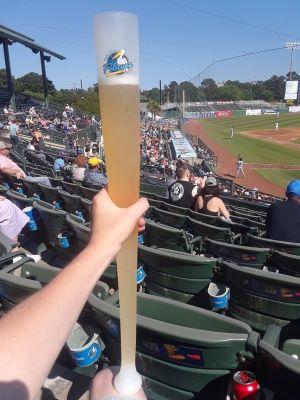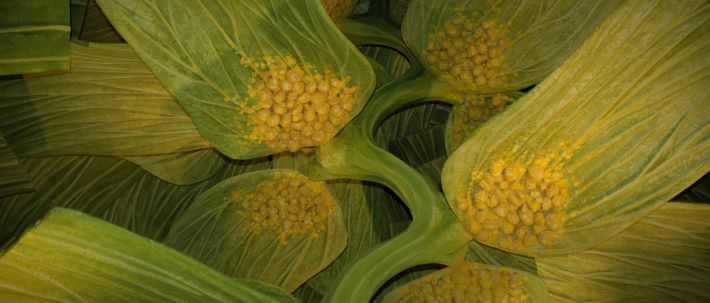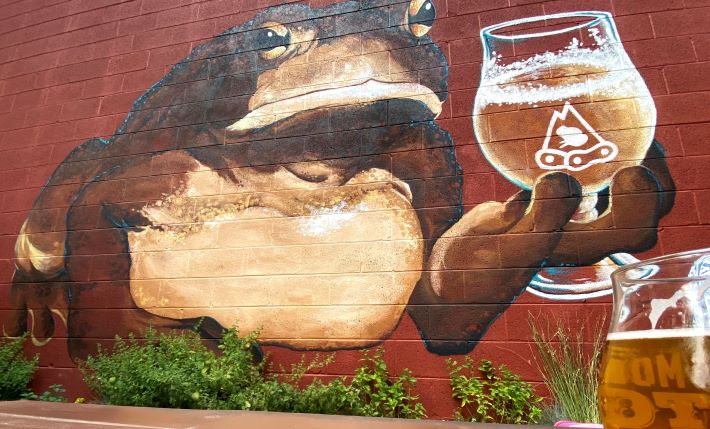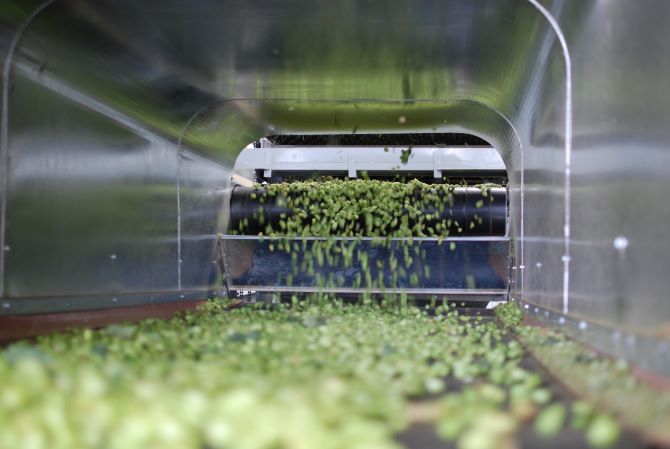A little more Monday retro-blogging . . . or come for the science, stay for the beer bats. Yes, beer bats, not beer brats. Links to stories you might have missed.
VinePair’s “Old Skills, New Tricks” series looks at “how drinks pros are taking on old trends with modern innovations.” The first about beer focused on canning sour beers (without talking to Ron Jeffries at Jolly Pumpkin Artisan Ales, which I do not understand). So far, I’ve found the one that asks if cutting-edge technology and character can coexist in winemaking the most interesting.
Because I might have had the technology/character conversation with brewers once or twice.
The process Christian Gastón Palmaz at Palmaz Vineyards has designed is definitely cutting edge. For instance, here’s how the grapes are chosen:
“Armed with a ‘four-axis vision system,’ the equipment considers each grape’s size, shape, color, and texture using a 3D stereoscopic camera. With the aid of an advanced AI algorithm, the machinery rapidly identifies the fruit, while 248 puffer air jets ensure anything that doesn’t meet the winery’s standards will not make it to the next stage of the journey. ‘We used to do this all by hand,’ Palmaz says, an almost lamenting tone to his voice. ‘This system is infallible. It’s becoming the gold standard of optical sorting for fruit.’”
These grapes produce juice that becomes wine in fermentation tanks that contain five independent heating and cooling zones and are hooked up to and controlled by a machine-learning, AI-assisted computer program. It monitors the activity of fermentation based on the speed that sound travels through the liquid, then adjusts the temperature accordingly.
The story details how Palmaz has broken down every aspect of viticulture and vinification to find how to do it better, more efficiently. At conferences, he discovered other winemakers are not as enthusiastic about attaining total consistency.
“That’s when it dawned on me that there is a large subset of the industry that truly believes a little bit of error in the process gives the wine character,” he says. So, speaking to a group, he will ask them if they have instructed their staff to make mistakes. None say they have.
“Why would they?” he says. “We all try to avoid mistakes but when they happen, we’re very quick to say, ‘It’s character.’”
I think it is a cop out to call it a mistake when one batch of beer, or wine, does not taste exactly like the last. When brewers, or winemakers, assess the raw materials at hand and make adjustments they might be forgoing a measure of consistency that Palmaz is striving for, but it feels more like character rather a mistake.
Further reading: New Beer Rule #4: Variation is not a flaw.
Further listening: Character Flaw, by Joe Ely. *And the source of this week’s headline.
Diversity
– Laura Garcia.
– Something is going on in a city where most people “are white, old-school, blue-collar and Yinzeree,” and the Pittsburgh Brewery Diversity Council is at the center.
Empty sentences
“It’s more about keeping in tune with where consumers are going, pivoting your product mix and meeting demands where there is growth — without being too staid in your habits. The good news is IPAs are still growing and hazies inside of IPAs are still growing, so there are still some good trends there.”
– From Q&A with Stone Brewing CEO Maria Stipp
On the lighter side
 We witnessed players in Chicago Cubs uniforms (but not the players who wore the uniforms when we bought the tickets) win a baseball game last week in Denver, a rare sight these days. I considered buying ice cream that comes in a helmet, but it is hard to get excited about collecting Cubs memorabilia right now.
We witnessed players in Chicago Cubs uniforms (but not the players who wore the uniforms when we bought the tickets) win a baseball game last week in Denver, a rare sight these days. I considered buying ice cream that comes in a helmet, but it is hard to get excited about collecting Cubs memorabilia right now.
However, had there been beer bats, even ones that carried a Rockies label and contained Coors Light, I would have paid silly stadium prices for beer (as it is, Coors Field is one more arena that could learn a lesson from Mercedes-Benz in Atlanta).
Who could resist? Apparently, whoever is in charge of promotions for the Rochester Red Wings does not understand this. Because the team ran out of bats last week during beer bat day. And, as Deadspin reported:
“It feels like it should not have been possible to underestimate the demand for beer bats. Take the capacity of your stadium, multiply it by the maximum number of beer bats that one fan would be allowed to buy before being considered overserved (this is where you have to know your market — some places can really put away the brews), and, boom, there’s how many beer bats you need per game — because people are going to max out on beer bats, which, again, are beers served in bats.”
(The photo is from a Budweiser tweet last May.)

 We witnessed players in Chicago Cubs uniforms (but not the players who wore the uniforms when we bought the tickets) win a baseball game last week in Denver, a rare sight these days. I considered buying ice cream that comes in a helmet, but it is hard to get excited about collecting Cubs memorabilia right now.
We witnessed players in Chicago Cubs uniforms (but not the players who wore the uniforms when we bought the tickets) win a baseball game last week in Denver, a rare sight these days. I considered buying ice cream that comes in a helmet, but it is hard to get excited about collecting Cubs memorabilia right now.
